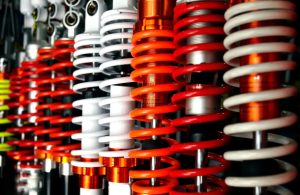When it comes to modern suspension systems, understanding the nuances between different technologies can be the key to appreciating ride comfort and vehicle dynamics. Two terms often used are adaptive and semi-active shock absorbers — and while they sound similar, there are important distinctions. This article will walk you through what each means, how they compare, and what implications they have for vehicle performance, maintenance, and cost.

Defining the Terms
Adaptive Shock Absorbers
Adaptive shock absorbers (sometimes also called “electronically adjustable”) refer to shock absorbers whose damping characteristics can be altered — typically by the driver via a mode selector (Comfort, Sport, etc.) or by a control unit selecting from discrete settings. For example, they may offer two or three damping levels. They do not continuously respond in real-time to every road irregularity in the way more advanced systems do. According to sources, adaptive suspension systems only vary the viscous damping coefficient and do not add energy to the system.
Semi-Active Shock Absorbers
Semi-active systems, by contrast, adjust the damping continuously (or very rapidly) in response to real-time sensor input about vehicle motion, road surface, and dynamics. They remain passive in the sense that they cannot add net energy into the system (they can’t push, only modify damping), but they can respond in milliseconds to changing conditions.
Key Differences at a Glance
| Feature | Adaptive | Semi-Active |
|---|---|---|
| Number of damping settings | Typically a few discrete modes (Comfort, Normal, Sport) | Continuously variable or very fast switching of damping coefficient |
| Response speed | Relatively slower (mode changes) | Very fast (milliseconds) |
| Real-time adaptation to road surface | Limited | High real-time adaptation |
| Energy input capability | No net energy added (just damping change) | Same: cannot add energy, only adjust damping |
| Complexity / cost | Lower complexity than full active suspension, but higher than passive | Higher complexity (sensors + control) but still less than fully active suspension |
| Typical usage | Vehicles where driver selects modes | Vehicles using dynamic control to adjust continuously |
How They Work
Adaptive Operation
In an adaptive system, the driver or vehicle control unit selects one of several predefined damping profiles. For example:
-
Comfort: softer damping → smoother ride
-
Sport: firmer damping → more responsive handling
This selection then tells the shock absorbers to change their internal valving or electronics accordingly.
Semi-Active Operation
Semi-active systems use sensors (e.g., wheel speed, body acceleration, steering input) feeding a control unit. The system then varies the shock’s damping coefficient very rapidly using solenoids, magnetorheological fluid, or electronically controlled valves. Because of this, the system is much more responsive to very small, high-frequency inputs from the road. For example, one technical review explains that semi-active suspension can adjust damping to optimal values in the 1st and 3rd quadrants of motion but cannot generate negative damping (2nd and 4th quadrants) unlike fully active systems.
Why Does This Matter?
Ride Comfort vs Handling
-
Adaptive systems give you a choice between modes — useful if you want a simpler adjustment.
-
Semi-active systems can better balance comfort and handling because they adjust continuously to road irregularities, rather than relying on a fixed “Sport” or “Comfort” setting.
Safety & Vehicle Control
Because semi-active systems respond rapidly to road inputs, they can help mitigate body roll, dive under braking, and squat under acceleration more effectively than simpler adaptive systems. For example, adaptive systems may simply switch to a firmer damping profile when Sport mode is selected, whereas semi-active systems monitor and respond to each bump or corner dynamically.
Cost and Maintenance
More complexity means higher cost. Semi-active systems require sensors, electronics, and more complex shock internals. Adaptive systems are simpler in comparison. For repair or maintenance, semi-active systems may demand more expertise and components. One aftermarket article notes how electronically adjustable suspensions are influencing the aftermarket sector and increasing complexity.
Practical Considerations for Buyers and Owners
Here are some lists and tips to help you decide or maintain these systems.
Pros & Cons
Adaptive Shock Absorbers
Pros:
-
Simpler than semi-active in terms of control and cost.
-
Offers selectable modes (driver control).
-
Easier to maintain relative to more sophisticated systems.
Cons: -
Fixed mode profiles may not suit every road condition.
-
Less responsive to dynamic changes in road surface.
Semi-Active Shock Absorbers
Pros:
-
Highly responsive to real-time road and vehicle inputs.
-
Better suspension behaviour (comfort + control) in dynamic driving.
Cons: -
Higher complexity and cost.
-
More components that may require specialized servicing.
-
Potentially higher repair cost if sensors/control units fail.
When to Choose Which
-
If you drive mostly in routine conditions, commute, and want comfort with occasional sport mode: Adaptive may suffice.
-
If you drive varied roads, want both comfort and high performance, or have a vehicle that pushes handling limits: Semi-Active is likely the better investment.
-
Maintenance-wise: if you plan to keep the vehicle long-term and avoid complex repairs, simpler systems may offer advantages.
Table: Technical Comparison
| Attribute | Adaptive Shock Absorber | Semi-Active Shock Absorber |
|---|---|---|
| Damping change mechanism | Mode selection, discrete profiles | Continuous adjustment via sensors + actuators |
| Typical reaction time | Slow to moderate (mode switch) | Very fast (milliseconds) |
| Sensor/control complexity | Moderate | High |
| Ride quality in mixed conditions | Good, but fixed profiles may be sub-optimal | Excellent, real-time optimisation |
| Cost & servicing | Lower cost, simpler maintenance | Higher cost, specialised maintenance |
| Typical vehicle segment | Mid-range to high-end | High-end performance & luxury vehicles |
Real-World Examples & History
-
The technology of electronically controlled shock absorbers goes back several decades. For instance, the Toyota Soarer in 1983 featured an electronic modulated suspension system (TEMS) which is considered a form of semi-active suspension.
-
One technical glossary states that “adaptive (adjustable)” suspension is the result of selecting two or more properties, whereas semi-active systems have controllability potential in real time.
Implications for Shock Absorber Replacement

If you own a vehicle equipped with adaptive or semi-active shock absorbers, here are a few things to keep in mind when it comes to replacement or upgrades:
-
Ensure compatibility: Because adaptive and semi-active systems use electronic controls, sensors, and sometimes unique fluid/valve technologies, replacements must match the original specifications.
-
Consider upgrading: If your vehicle originally had adaptive shocks and you’re looking for better handling, you might consider aftermarket semi-active kits (if available) though this often means additional control module integration.
-
Maintenance: Regularly inspect for sensor faults, electronic control issues, and ensure that the shock absorbers used are appropriate for the system type.
-
Availability: You may search and purchase suitable shocks online. For example, you might go here: Buy Shock Absorbers online
Summary & Take-Away
-
Adaptive shock absorbers allow the driver or control unit to switch between discrete damping profiles (Comfort, Sport, etc.).
-
Semi-active shock absorbers dynamically adjust damping in real time based on sensor feedback and control logic, delivering a higher level of real-time adaptability.
-
While both offer improvements over purely passive suspension systems, semi-active systems provide superior performance and responsiveness—but at increased complexity and cost.
-
For everyday driving with occasional spirited use, adaptive may be perfectly adequate. For dynamic driving, varied terrain, or performance vehicles, semi-active may deliver meaningful benefits.
In the end, choosing the right suspension system (or selecting the right replacement shocks) depends on your vehicle use-case, budget, and how important ride and handling trade-offs are to you.
Note: The suspension system is only one part of vehicle dynamics. Geometry, springs, anti-roll bars, tires and overall chassis design also heavily influence ride and handling. Still, picking the correct type of shock absorber technology — adaptive vs semi-active — is a key decision.
Good luck with your upgrade or replacement, and remember: for genuine results, ensure you match the system type and quality of the components.